
Guests
- Subhankar Banerjeerenowned photographer, writer and activist who has spent the past decade working for the conservation of the Arctic and raising awareness about indigenous human rights and climate change. He is editor of the newly published book, Arctic Voices: Resistance at the Tipping Point.
As the oil giant Shell prepares to begin exploratory drilling in the Arctic, activists across the world have begun holding protests. The Obama administration has set a deadline for next month to decide on whether to grant the final drilling permits. Over the last decade, Arctic Alaska has become the most contested land in recent U.S. history. But in addition to oil, natural gas and coal, the Arctic is rich in biodiversity and has been home to generations of indigenous people for thousands of years. We’re joined by Subhankar Banerjee, a renowned photographer, writer and activist who has spent the past decade working to conserve the Arctic and raise awareness about human rights and climate change. Banerjee is editor of the newly published book, “Arctic Voices: Resistance at the Tipping Point,” and has just won the 2012 Lannan Foundation Cultural Freedom Award. [includes rush transcript]
Transcript
JUAN GONZÁLEZ: Oil giant Royal Dutch Shell’s plans to drill in the Alaskan Arctic drew more protests this week when one of its ships almost ran aground there Saturday. The Noble Discoverer is one of two vessels that will drill exploratory oil wells in the Chukchi and Beaufort Seas this summer. Activists with Greenpeace forced dozens of Shell sites to temporarily shut down this week as part of a global protest to stop the drilling. At a gas station in London, they managed to place an animatronic polar bear on the station’s roof.
SARA AYECH: Shell are going to be the first big oil company, this summer, to start drilling for oil in the Arctic. The Arctic is a unique and beautiful area of the planet. And to drill for oil there would endanger the wildlife, the habitat of polar bears and narwhals and other creatures—as well as the four million people who live there. People all over the world are taking action like this and hoping that Shell will listen and hoping that Shell will make a decision not to go and drill for oil in the Arctic.
JUAN GONZÁLEZ: Shell says it’s invested more than $4 billion in its Arctic drilling venture. Next month, the Obama administration is set to decide whether to grant the final drilling permits.
AMY GOODMAN: Over the last decade, Arctic Alaska has become the most contested land in recent U.S. history. But in addition to oil, natural gas and coal, the Arctic is rich in biodiversity. It’s also been home to generations of indigenous people for thousands of years. Now, amidst a record heat wave, there’s growing concern about the role fossil fuels play in climate change.
For more, we’re joined by Subhankar Banerjee, renowned photographer, writer, activist, who’s spent the past decade working to conserve the Arctic and raise awareness about human rights and climate change. He’s editor of the newly published book, Arctic Voices: Resistance at the Tipping Point. And he just won the 2012 Lannan Foundation Cultural Freedom Award.
Welcome to Democracy Now!, Subhankar.
SUBHANKAR BANERJEE: Thank you, Amy. Thank you, Juan.
AMY GOODMAN: Talk about the significance of this area and Shell’s now moving in to do exploratory drilling, what that means, where this is in the Arctic.
SUBHANKAR BANERJEE: So, the thing is that the most dangerous form of drilling anywhere on earth is moving forward, which is Shell’s impending drilling. It’s in the Chukchi Sea. It’s the American Arctic, which is in Alaska. Chukchi Sea is on the western and the northwestern side, and the Beaufort Sea is on the north. So these two seas are two seas of the Arctic Ocean. And we have no understanding of the Arctic ecology. The Obama administration has not done an environmental impact statement. And this drilling is moving forward despite tremendous protest from the Iñupiat activists who have been fighting this and the environmental groups who have been fighting this. And just to summarize where we are today, I can give you the best—who have been struggling over at least 12 years.
To give you an analogy of this Shell’s Arctic drilling, what this means, Shell is like a little kid, wants to eat his candy, hasn’t done his homework, but worse yet, didn’t brush his teeth, so it stinks. And if you keep eating your candy and don’t brush your teeth, you—results in cavities. And you don’t go to the doctor and clean up your teeth and fix your cavities. That’s where we are right now, and I mean it in every sense of the word, is when we look at Shell’s Arctic drilling, we need to look at Shell’s history of drilling in the immediate past and now.
And I’ll give you just two examples of how horrible and horrendous Shell’s record is. It’s like when we go try to get an apartment to rent, we always are asked last two years of tenancy record. In Nigeria, in the Niger Delta, last year the United Nations Environment Programme released an extensive report that said that Shell and other oil companies have systematically destroyed 1,000 square kilometers of the Niger Delta and the livelihoods of the Ogoni people. And U.N. said that it will take 30 years to repair the Niger Delta, possibly more. And then you look at the Siberia, in the Sakhalin Island, Shell, despite the protests from the indigenous people, dumped more than a million tons of dredging waste into the Aniva Bay, destroying the fisheries and the indigenous communities, and built a oil platform right where, despite tremendous protest, where the last 100 critically endangered Pacific gray whales feed.
None of this is in the news in the U.S. All we talk about, like, Juan, you mentioned, the $4 billion Shell has spent. They’re making enormous profits at the expense of these things. We have to look at that. And then, of course, their current drilling is full of holes. Like I said, it’s like cavities in your teeth. It’s completely full of holes. And the indigenous people and the environmental organizations are pointing this out. And the Obama administration really has to pay attention, which they have not been so far.
JUAN GONZÁLEZ: Now, you make the point that if there is a spill in the Arctic, it could be far more dangerous ecologically than, for instance, even what happened with BP in the Gulf.
SUBHANKAR BANERJEE: Absolutely, because the Arctic is an incredibly harsh environment. I have spent time there in all seasons, including winter. And you’re talking about 35-, 45-below-zero temperatures; 65-, 85-miles-per-hour wind blowing; 120-below-zero sea ice, extremely powerful sea ice, moving, because sea ice is not static, by the way; and dealing with the Arctic oil spill. And Shell plans to do even the exploratory drilling in Beaufort Sea through end of September and the Chukchi, end of October, or the other way around. And by mid-September, you already have sea ice in the Arctic Ocean. And by about first week of October, you have the Arctic Ocean mostly frozen. And any spill happens, Shell has acknowledged that they will have to leave the oil in place until the next summer drilling season, which is nine months away, and kill the Arctic Sea. This is unacceptable.
AMY GOODMAN: I want to play a clip of Marvin Odum, who’s president of Shell Oil Company. This is from a recent interview with Bill Loveless of Platts Energy Week TV.
MARVIN ODUM: You see a lot and you hear a lot about it being a very stressed relationship.
BILL LOVELESS: Right.
MARVIN ODUM: And that’s real. I mean, we should just be honest about the fact that that’s real.
BILL LOVELESS: Is it as harsh, though? I mean, because the oil industry often, generally speaking, paints the administration as having roped up all—roped off all of access to oil and gas onshore federal lands, offshore waters, and at the same time, your company has been—you know, consistently been getting the permits you need for this rather large project from the administration.
MARVIN ODUM: Yeah, and I think it’s a recognition of how strategically important Alaska is and offshore Alaska is to the U.S. and to U.S. energy security. So, you know, if you go to the government estimates, we’re talking about, you know, 25-plus billion barrels potentially that sit in this part of the Arctic. Now, that could be oil for the U.S. That could be energy security for the U.S., as well as the jobs and the economic benefits that go along with that. And I think what we’ve seen in the administration is a recognition that this is a strategic resource. And it’s one that, if we’re convinced we can do it the right way, it should be developed. And now we’re finally to that point.
AMY GOODMAN: That’s the Shell Oil president, Marvin Odum. Subhankar Banerjee, your response?
SUBHANKAR BANERJEE: That’s precisely the point—if we can do it the right way—which is exactly what the Obama administration so far has been avoiding. And I’ll tell you exactly where we are. This drilling is moving forward, and the first thing the National Environmental Policy Act requires, that whenever there is any significant doubts about what drilling could do, you have to do an environmental impact statement. The administration has not done an environmental impact statement. And they instead issued what is called a “finding of no significant impact,” meaning they’re saying there will be almost no oil spill, which is exactly what BP said about their spill—exploration plan in the Gulf of Mexico.
So, the point is that it’s not that who knows what will happen with drilling in future. Right now the administration must stop Shell’s drilling this year, because we already know, at the beginning, as you mentioned, that just this past week that their drill ship, Noble Discoverer, grounded—actually, not just adrift in the sea, but grounded. From the photo, you can see that it is grounded. And that is Dutch Harbor. The Arctic Ocean is a hundred times harsher place than that. And so, that’s the point. Their spill response plan is full of holes. Shell said, in their spill response plan, they’ll be able to clean up 95 percent of the spilled oil, whereas in Exxon Valdez spill we had about 8 percent recovered, and in the Gulf of Mexico Deepwater Horizon we had less than 10 percent recovered. And here, Shell is saying 95 percent, under the Arctic ice. What ridiculousness! And these things is moving forward so fast.
The point is that—pay attention to what the environmental groups are saying. Pay attention to what the scientists are saying. Pay attention to what NOAA is saying, the U.S. government. Pay attention to what Coast Guard is saying. Pay attention to what the USGS is saying. And all of they are saying Shell is not ready. That’s the point.
JUAN GONZÁLEZ: Well, one person who doesn’t seem to be paying attention is President Obama. I want to play a comment from the president in May of 2010, when he announced the expansion of offshore oil and gas exploration.
PRESIDENT BARACK OBAMA: Under the leadership of Secretary Salazar, we’ll employ new technologies that reduce the impact of oil exploration. We’ll protect the areas that are vital to tourism, the environment and our national security. And we’ll be guided not by political ideology but by scientific evidence. That’s why my administration will consider potential areas for development in the Mid and South Atlantic and the Gulf of Mexico, while studying and protecting sensitive areas in the Arctic. That’s why we’ll continue to support development of leased areas off the North Slope of Alaska while protecting Alaska’s Bristol Bay.
JUAN GONZÁLEZ: That was President Obama speaking in 2010. He made these comments while speaking at Andrews Air Force Base, standing in front of a fighter jet.
SUBHANKAR BANERJEE: And you know how I remember that image? Because images are very powerful in our culture, visual imagery. And I remember that image, President Obama standing in front of a F-18 Hornet fighter jet in Andrews Air Force Base with an American flage behind him.
PRESIDENT BARACK OBAMA: Under the leadership of Secretary Salazar—
SUBHANKAR BANERJEE: And that was March 31, before the BP spill. And it’s almost that image, to me, is like that little girl ripping off her clothes and running from the napalm bombing that changed our consciousness of the horrors of war. This image reminds me of that, and we need to look at it carefully. And what has happened is that, during the Bush era, Bush administration, we were much—there was much talk about reducing of our dependence on foreign oil. And that particular phrase, reducing our dependence on foreign oil, was taken up by both the environmental community, to take America towards clean energy path, and by big oil and clean coal, towards taking America for the next 100 years of fossil-fuel-driven energy. And so far, the big oil and clean coal is winning. And President Obama’s decision actually takes that path. And that’s what is so disturbing. So, beyond all the immediate dangers of Shell’s drilling in the Arctic Ocean—we can talk about all of that, we know that—but it’s also where are we heading, with all this climate change that’s happening.
JUAN GONZÁLEZ: But I wanted to ask you, with this whole emphasis on Alaska as now part of the strategic future of the United States and energy, it’s not just oil, it’s also coal, as well, right?
SUBHANKAR BANERJEE: Yes, yes.
JUAN GONZÁLEZ: Could you talk about the importance of coal in Alaska?
SUBHANKAR BANERJEE: Yes, yes, and America knows nothing about it, and it makes the entire West Virginia and Wyoming drop in the bucket. In the western Arctic of Alaska, a place called Utukok River Upland, which is inside the National Petroleum Reserve, Alaska, 23.5 million acres, public land, the largest public land in the U.S., we have an estimated four trillion ton of bituminous coal. We consume about a billion ton of coal each year in the U.S., so we are talking about 4,000 years of U.S. coal sitting in that place. But right where the coal is is exactly where the largest caribou herd of North America gives birth. It’s their calving ground, called the Western Arctic Caribou Herd. It’s about 377,000 strong. It was about 500,000 strong a few years ago. With climate change, of course, caribou herds all over the Arctic are being impacted very heavily. And that coal is there.
So, the point that I’ve been making in the last two years is that with that Arctic coal, with the Arctic oil, with what’s going on in tar sands that Bill McKibben and others have been fighting, with all of the Shell oil and Shell gas in the western United States, we are talking about a hundred years of fossil-fuel-driven culture in the U.S. Is this the path we want to take? That’s the question as a society, both as a moral question as well as a practical question, we have to respond to.
AMY GOODMAN: Subhankar Banerjee, you have been at this for a long time. You edited Arctic Voices: Resistance at the Tipping Point. You’re also a great photographer. Talk about your own personal story and what happened to you at an exhibit at the Smithsonian that was featuring your work.
SUBHANKAR BANERJEE: Well, you know, during the—President Bush’s administration, his top energy priority was to open up the Arctic National Wildlife Refuge to oil drilling, which—
AMY GOODMAN: What we knew as ANWR.
SUBHANKAR BANERJEE: ANWR, which, at that time, was the most debated public land in the U.S. history, and the debate was going on for about five decades. And again, it’s a combination. It’s a resource war, human rights issues of the Gwich’in Athabascan people, that, Amy, you may remember you spoke with both me and Sarah James, the renowned Gwich’in elder and activist, in Copenhagen the very first day of the Copenhagen climate summit.
So, my first book had come out in 2003 called Arctic National Wildlife Refuge: Seasons of Life and Land. The first exhibit was to open at the Smithsonian Institution in D.C. Senator Barbara Boxer used my photographs of a polar bear. And she won a crucial vote, 52 to 48, to the dismay of the Bush administration and Dick Cheney, Vice President Dick Cheney. And immediately, my exhibit was censored. It was pushed down to a basement corridor. All of the interpretive texts were taken out. But then it resulted in a Senate hearing, in which it—
AMY GOODMAN: But, wait. Why was it censored?
SUBHANKAR BANERJEE: It’s just because—and there was nothing, no oil. The word “oil” wasn’t even mentioned. Just the fear, because Senator Barbara Boxer used my image during a Senate debate and won, and that made it very political. That is the photograph.
AMY GOODMAN: And for our radio listeners, they can go to our website to see some of these photos. But your images of the polar bear eating whale?
SUBHANKAR BANERJEE: Well, that was done like a little bit before. That is a very disturbing—this is the one. This is the one that Senator Boxer used.
AMY GOODMAN: And describe it for—
SUBHANKAR BANERJEE: And this is in the Beaufort Sea, exactly where Shell wants to drill for oil, right there. And this was taken in early June, and the bear is essentially reaching towards a whale bone left behind from the hunt by the Iñupiat people of Kaktovik. And it’s a reflection. And, I mean, it isn’t really a global warming image, but you can see ice, is on top of ice. And she used that image to argue that Arctic National Wildlife Refuge needs to be preserved. And it became very controversial. There became a Senate hearing in Senator—in which Senator Richard Durbin defended my work. And later on, Senator Ted Stevens, late Senator Stevens, said—
AMY GOODMAN: Ted Stevens, now deceased, from Alaska—
SUBHANKAR BANERJEE: Deceased, yes.
AMY GOODMAN: —who was indicted, convicted, and then his conviction overturned.
SUBHANKAR BANERJEE: Absolutely, and one of the most powerful senators in the U.S. history. He said that President Jimmy Carter and I were giving misinformation to the American public on the U.S. Senate floor in May, late May 2003. And I got really scared. I was not a citizen. I realized that if I were to have a voice—and all the PATRIOT Act hoopla was going on that time, so I was really scared. Looking back at it, it seems amusing, but it was very scary. And I decided to become a citizen, because I wanted to have a voice in U.S. conservation. So that—so, I was not an activist, and I think that image and Senator Boxer showing it kind of led me to the activist path, which I have become now, to really fight for indigenous human rights and climate change and these resource wars issues.
AMY GOODMAN: From India to the United States to the Arctic is a quite a long journey through many climates.
SUBHANKAR BANERJEE: Yes, and it’s been kind of a zigzag path. And in Arctic Voices, in my introduction, I called it “Kolkata to Kaktovik,” so it’s this really long, circuitous route that we take.
JUAN GONZÁLEZ: I want to ask you about a comment by Interior Secretary Ken Salazar on the window of opportunity for Shell’s offshore oil drilling in the Arctic this summer. He said Tuesday that, quote, “We have not yet given the final permits to Shell. … We don’t know if it will occur, and if it does occur, it will be done under the most watched program in the history of the United States,” unquote. Salazar also said he would make a final decision on whether to issue drilling permits by August 14th. Your response?
SUBHANKAR BANERJEE: This is great, in the sense—this is actually great news, what Salazar has said, because until that point it was basically given the media would make you believe Shell has gotten all the permits, Shell is drilling, and so on and so forth. This is the first time from the administration we hear they have not given all the permits and Shell might not go there. And that’s the point. And from based on what’s going on—Shell’s drill ships are drifted and grounded—that Shell is now asking that they cannot even meet the air quality rules—Noble Discoverer, they said that. And their barge has not gotten the U.S. Coast Guard certification. This is the time. So, Secretary Salazar should take this seriously, stop Shell’s drilling now, because, honestly, even if he gives the permit—let’s say drilling begins August 15—you have only four weeks of drilling season or five weeks of drilling season. And the month of September—the viewers should understand, the month of September is exactly when the bullhead whales, the endangered bullhead whales, that we wiped out nearly, led them to extinction in the late 19th century, migrate through the Beaufort and Chukchi Seas, exactly, with their calves.
JUAN GONZÁLEZ: So a decision coming on August 15th, in the middle of a presidential campaign—
SUBHANKAR BANERJEE: Yes.
JUAN GONZÁLEZ: —is sort of an open invitation to the environmental community to begin to put the pressure on the Obama administration.
SUBHANKAR BANERJEE: Absolutely. And honestly, and I think Michael—Glenn Greenwald has pointed this out again and again, that unless we speak out and pressure the administration, he’s not going to act. And this is the time to pressure the administration. And I think the environmental community is doing a fantastic job. With Greenpeace, Alaska Wilderness League is doing a fantastic job. They collected one million signatures in May, delivered to President Obama, and all of the vigil and everything that’s going on. So I think this is a very good time.
AMY GOODMAN: Subhankar, what about this latest news, the iceberg twice the size of Manhattan broken off from one of Greenland’s two main glaciers, the Petermann Glacier, the second time in two years that part of the Petermann Glacier has broken off, after an ice island four times Manhattan’s size cracked apart in August of 2010—the significance of this?
SUBHANKAR BANERJEE: Absolutely. And the significance of this is this. Not only the damage we are causing to the Arctic or the nature up there, but the nature is going to fight back—meaning, when you have such a large iceberg doing that, falling off, all the scientists have been saying that the melting of the Arctic sea ice, as well as the melting of the ice cap of Greenland, is going to cause enormous sea rise, level rise. Right here in New York City, New York coastline is completely threatened, as well as all of the coastlines of all of the northern hemisphere cities. We cannot ignore this. All of these discussions have to be on the table. This is the time. Arctic is telling us something. Climate change is—climate change is kind of the canary in the coal mine. That’s where we are seeing the most impact. And here is an example right now, right in front of us, that this something like four times the size of Manhattan falls off.
AMY GOODMAN: Subhankar Banerjee, I want to thank you very much for joining us again. And if folks want to see some of his photographs, you can go to our website at democracynow.org. Subhankar is a renowned photographer, writer and activist, spent the last decade working for conservation of the Arctic. His latest book is called Arctic Voices: Resistance at the Tipping Point. This is Democracy Now!, democracynow.org, The War and Peace Report. And on our website, we have highlighted one of the chapters at democracynow.org.
When we come back, we’re staying with the issue of climate change to talk with Mark Hertsgaard, who started Climate Parents. What are parents doing for their children about the world changing, heating up? Stay with us.

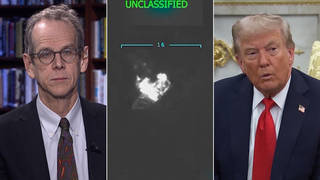

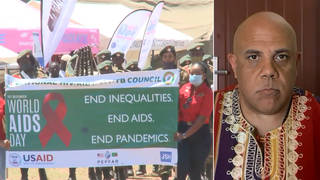
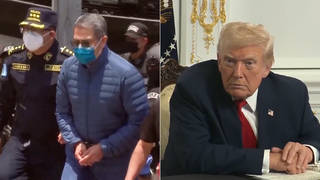





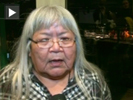
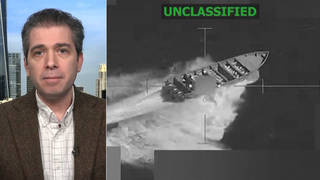
Media Options